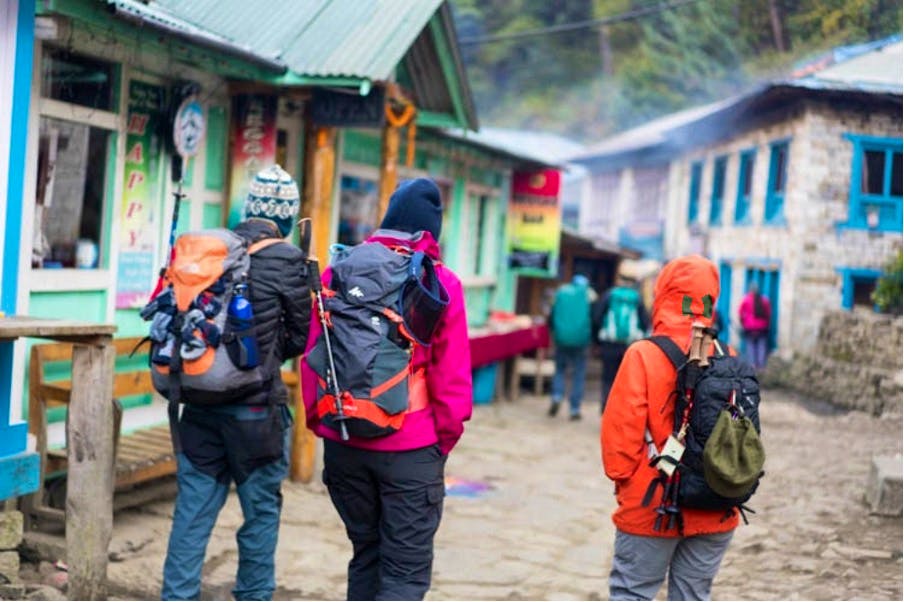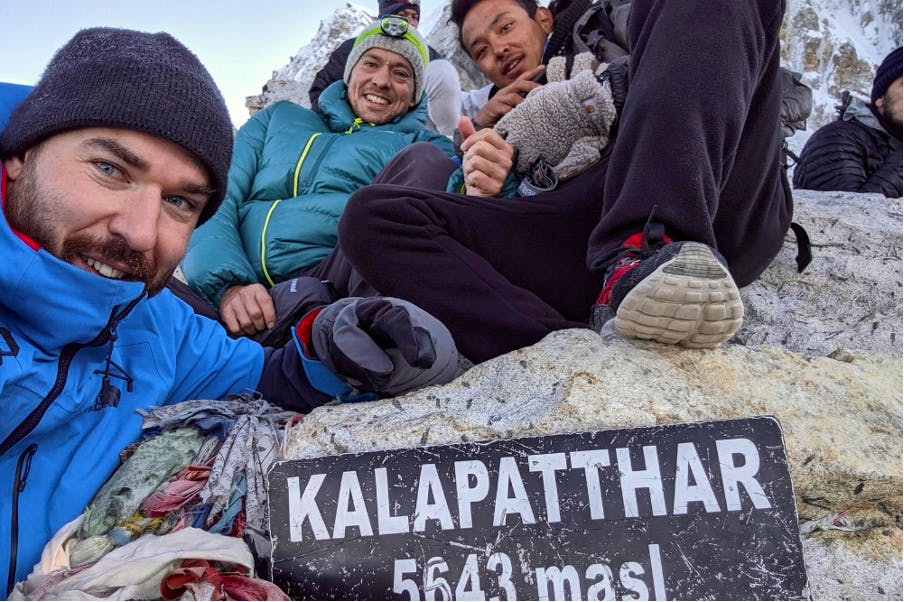Essential Everest Base Camp Packing List
Doing the awe-inspiring hike to Everest Base Camp is the adventure of a lifetime, and packing right is half the battle won. That's why we've assembled the essential Everest Base Camp packing list to ensure you're well-prepared for this epic journey.
Your Packing List for Everest Base Camp Trek
Based on our experience, you'll need the following gear for the ultimate adventure to Everest Base Camp.
The Essentials: Gear You Can't Ignore
When it comes to trekking, especially on a challenging route like Everest Base Camp, the right gear can make all the difference.
At Skyhook, we've seen firsthand how essential items can turn a strenuous trek into a more manageable and enjoyable experience.
Here's our curated list of must-have gear, each item selected for its durability, functionality, and comfort.

Duffle Bags vs Backpack
If you are taking a porter, then I suggest getting a 90L duffle bag. Porters prefer carrying a duffle than a backpack, and it's a lot easier to fit all your belongings in a duffle. Duffles are also very durable and can withstand the rough terrains of the Himalayas. Assuming you have a porter to carry your bag, you will then just need a 20L daypack for essentials.
Obviously, if you don't have a porter, than a top-loading backpack (ideally 50L+) is required.
Trekking Poles
Trekking poles help distribute your body weight, reducing the impact on your knees and making those steep ascents and descents much more manageable.
Headlamp
A headlamp is crucial for those early-morning starts or late-night toilet runs. Opt for one with adjustable brightness and long battery life.
Multi-tool Kit
A multi-tool kit can be a lifesaver in unexpected situations. From cutting ropes to opening cans, it's a versatile item you'll be glad you packed.
Water Purification Tablets
While bottled water is available, it's both expensive and not eco-friendly. Water purification tablets are a lightweight and effective way to ensure you have clean drinking water throughout the trek. Just make sure you also boil water before treating it.
Portable Charger
With limited access to electricity, a portable charger ensures your devices stay powered, allowing you to capture every breathtaking moment. And trust us, the view from Everest Base Camp is worth capturing.
Thermal Flask
A thermal flask keeps your beverages hot or cold for extended periods, a blessing in fluctuating weather.

Clothing: Mastering the Art of Layering
While trekking in the Everest region, you want your clothing to be as adaptable as you are. Here's what we recommend you pack:
Base Layers
A moisture-wicking base layer, preferably made of merino wool, keeps you dry by pulling sweat away from your skin. This is essential for regulating body temperature and preventing hypothermia.
Mid Layers
A fleece jacket serves as your mid-layer, providing the necessary insulation. It traps heat between the base layer and itself, creating a warm air pocket around you.
Outer Layers
You need two outer layers. A waterproof and windproof outer layer, like a Gore-Tex jacket, shields you from rain, snow, and wind. And a down or good synthetic-fill jacket layer to keep you warm in the cold temperatures on the EBC trail. It's your final line of defence against the elements.
Layering Extras
Remember a sun hat for the daytime and a beanie for the colder evenings. Gloves are also necessary, and it's wise to bring lighter and heavier pairs to adapt to changing conditions.
Did you know? The beauty of layering lies in its flexibility. As you ascend or descend, you can easily add or remove layers to maintain optimal comfort. And remember, each layer should be breathable to allow moisture to escape, preventing dampness and chills.

Weather & Seasons: Packing for the Unpredictable
If there's one thing we've learned from our years of trekking with Skyhook, it's that the weather in the Everest region can be a fickle friend. Packaging for these varying Everest Base Camp weather conditions would be best.
Sunny Days
A wide-brimmed hat, UV-protective sunglasses, and high-SPF sunscreen are essential for sunny days. The sun's rays are much more potent at higher altitudes, making sun protection crucial.
Rainy Conditions
A lightweight, waterproof rain jacket and rain cover for your backpack are must-haves. These items ensure you and your gear stay dry, even during unexpected downpours.
Cold Weather
Thermal underwear, woollen socks, and insulated gloves are your best bet for cold weather. These items provide the extra warmth you'll need, especially during early mornings and late evenings.
High Winds
A windproof outer layer and a neck gaiter can make a world of difference when facing high winds. These items protect your face and neck from the biting cold and keep you comfortable.
Altitude Changes
As you gain altitude, temperatures can drop dramatically. Packing a set of thermal layers allows you to adjust your clothing as needed, ensuring you're always at the right temperature.
Pro tip: The key to packing for unpredictable weather is versatility. Choose items that can serve multiple purposes and can be easily layered or removed.

Footwear: The Foundation of Your Trek
If there's one area where you shouldn't skimp, it's your footwear. After all, your feet are the foundation of your trekking experience.

Latest Deals
Hiking Boots
A pair of high-quality, waterproof hiking boots offers the ankle support and grip you need on varied terrains. Make sure they're well-fitted and broken in before the trek to avoid blisters and discomfort.
Pro tip: Try wearing your boots as part of your Everest Base Camp training.
Trekking Socks
Merino wool trekking socks are your best bet. They wick moisture away, provide cushioning, and have natural anti-bacterial properties that help prevent odours.
Gaiters
Gaiters are often overlooked but can be a game-changer. They prevent rocks, mud, and snow from entering your boots, keeping your feet dry and comfortable.
Insoles
Custom or quality insoles can provide additional arch support, making long days of trekking much more bearable.

First Aid & Toiletries: Small Items, Big Impact
While the grandeur of the Everest Base Camp trek is awe-inspiring, the small items in your pack often have the biggest impact on your experience.
First Aid Kit
A basic first-aid kit with band-aids, antiseptic wipes, and pain relievers can be a lifesaver. Whether it's a minor cut or a headache, having these items on hand ensures you can address minor issues immediately.
Blister Plasters
Blisters can turn a trek into a painful experience. Blister plasters provide immediate relief and help you continue trekking without discomfort.
Rehydration Salts
Dehydration is a common issue at high altitudes. Rehydration salts quickly restore lost electrolytes, helping you stay hydrated and energised.
Insect Repellent
Insects can be a nuisance, especially in lower altitudes. An effective insect repellent keeps those pesky bugs at bay.
Sunscreen & Lip Balm
The sun's rays are stronger at higher altitudes. A high-SPF sunscreen and lip balm with sun protection are essential for preventing burns.
Wet Wipes & Hand Sanitiser
With limited access to showers, wet wipes are a convenient way to freshen up. Hand sanitiser is crucial for maintaining hygiene, especially before eating any Everest Base Camp food.
Personal Medication
If you're on any prescription medication, make sure to bring an adequate supply, as it may not be readily available during the trek.

Insurance and Permits: The Paperwork You Need
While the thrill of the Everest Base Camp trek lies in its unpredictable nature and stunning vistas, one aspect requires meticulous planning: paperwork.
Trekking Permits
Two permits are generally required for the Everest Base Camp trek: the Khumbu Pasang Lhamu Rural Municipality Permit and the Sagarmatha National Park Entry Permit.
Obtaining these permits is essential for legal trekking and contributes to the conservation efforts in the region.
TIMS Card
The Trekkers' Information Management System (TIMS) Card is another requirement. While some say it's not strictly enforced, it's better to be safe than sorry.
Travel Insurance
Comprehensive travel insurance, like EBC insurance, covering high-altitude trekking, emergency evacuation, and medical expenses, is non-negotiable. Ensure your policy covers you up to an altitude of at least 5,500 meters.
Helicopter Rescue Coverage
In the unfortunate event of a severe medical emergency, helicopter rescue may be necessary. Ensure your insurance policy includes this coverage.
Document Copies
Always carry photocopies of all your permits, insurance documents, and identification. In case of loss or theft, having copies can expedite the replacement process.
Local SIM Card
A local SIM card can be invaluable for communication, especially in emergencies. Make sure to get one that offers good coverage in the Everest region.

To Buy or To Rent: That Is the Question
Buying or renting trekking gear is often a dilemma for adventurers. We've weighed the pros and cons to help you make an informed choice.
Buying Gear
Pros: You get brand-new, high-quality items tailored to your needs. Plus, you can use them for future treks.
Cons: The initial cost can be high. You'll also have to carry the gear back home.
Skyhook's Tip: If you opt to buy, Kathmandu has numerous stores offering a range of quality and prices. Just make sure to test everything before purchase.
Renting Gear
Pros: It's cost-effective and eliminates the hassle of carrying gear back home.
Cons: The equipment may be worn and not ideally suited to your needs.
Skyhook's Tip: Namche Bazaar offers rental options, but renting from reputable stores in Kathmandu is advisable for better quality.
Whether you buy or rent, the key is prioritising quality and fit. After all, the right gear can make or break your Everest Base Camp experience.
Conclusion
Conquering an Everest Base Camp trek is a monumental experience, and the proper preparation can elevate it from memorable to extraordinary. With our expert guidance and this comprehensive packing list, you're well-equipped to face any challenge the Himalayas throw your way.
More EBC Articles
Popular EBC Trips
Find your next adventure
Why Skyhook?
Join over 27,000 Skyhook adventurers who've used our platform to book directly with our vetted local guides, at local prices (we never markup).
Expert Local Guides
Experienced local guides, handpicked by us.
Best Prices
Never pay a markup on the local guide's price.
Exclusive Club
Earn loyalty rewards every time you travel.
Great Social Vibes
Small group tours provide a richer experience.
Stellar Feedback
Over 2,800 reviews, average of 4.9/5 stars.












